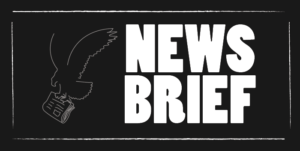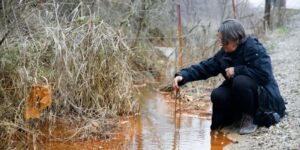Photo by: Will Gentry
After years of halted construction, the Oklahoma City American Indian Cultural Center and Museum may finally receive a completion date.
Initial construction began in 2005, but according to Native American Cultural and Educational Authority CEO Blake Wade, construction stopped in 2012 when state funding dried up.
According to the Oklahoma Gazette article “Bright History, Vibrant Future,” ever since the halt in construction, political controversy has surrounded the project with some lawmakers opposed to any new funding.
The state senate passed a measure on funding the museum $40 million from the Oklahoma Unclaimed Property Fund on March 4. This bill, combined with another $40 million funded by private pledges from Oklahoma’s 39 tribes, individuals and companies will help aid in the “bright future” of the museum and cultural center.
Also according to the Oklahoma Gazette, the museum – located along I-40 between I-35 and Eastern Avenue – is estimated to bring in 250,000 visitors annually and produce about $3.5 million in revenue when opened.
“Everything you would expect to see will be there,” Shoshana Wasserman, director of communications and cultural tourism for the Native American Cultural and Educational Authority, said to the Oklahoma Gazette. “The last three or four years have been about the funding and not the cultural experience people will have. This [museum] will change the minds of people from outside Oklahoma.”
Wasserman, a member of the Muscogee Creek tribe, explained that the museum will represent all of the Oklahoma Native American tribes.
“[Visitors] will see there are 39 distinct Indian nations with 12 different language families converging in Oklahoma, each with its own story to tell across the state,” Wasserman said. “This will truly be an authentic experience – not one that is staged. There will be information about how each tribe came to Oklahoma, where they came from and their journey here. People will see there are multiple Trails of Tears, not jut one.”
Other Oklahoma Native Americans share Wasserman’s enthusiasm for displaying more than just the better-known tribes within the museum.
“I think we learn a little bit about Native Americans in school, but not as much as we could,” sophomore Drew Swadley said. “I think a lot of people, even those who aren’t Native Americans, could learn a lot from the museum.”
Education is a predominant goal of the museum as Wasserman explained, and it is not just for Native Americans.
“People think this is just for Indians, but that’s not true,” Wasserman said. “It’s for everyone in Oklahoma and the rest of the world.”
Matt McCook, an associate professor of history, agreed that the museum will help educate any type of person about Oklahoma’s Native Americans.
“While people probably won’t come down here specifically for [the museum], it does add just one more thing for people to see when in Oklahoma City,” McCook said. “Oklahoma seems proud of its native heritage, and there are a lot of people who can trace their ancestry back to one or more tribes here in Oklahoma.”
Some people seem to have high expectations for the museum and what it will offer.
“I would really like to go because I don’t know a lot about Oklahoma Native American culture,” Swadley said. “I know my tribe has a little center in Lawton. It’s a two-hour drive from here and it isn’t very big.”
The cultural center will prominently feature the Courtyard of the Winds, a symbolic outdoor representation of the 12 language families, and four theaters of various sizes, including a 250-seat multipurpose forum for film screenings and other events. Also planned is a museum café and programming that will be changed periodically.
The programming will involve book signings, live music, seasonal celebrations, annual festivals, hands-on workshops directed by world-renowned Native American artists, storytelling, lectures and other demonstrations of Native American dance, music and theater performances.
“The exciting thing for me is this would give all of our American Indians the opportunity to bring in their art and sculptures,” Wade said. “Everybody has been going out to Santa Fe [New Mexico], and we are going to be able to now have a place of our own where people can buy American Indian art and sculptures.”
Despite the public’s positive anticipation of the museum’s completion, not all see a bright future for the museum.
According to the NewsOK article “Oklahoma Senate Passes Indian Museum Bill,” House Speaker Jeff Hickman has hinted that the bill is likely to receive a “chilly reception” once it gets to the state House of Representatives.
Senator Mark Allen refers to the museum construction project’s troubled history with its supporters when he criticized the bill to NewsOK.
“Can you tell me how many broken promises have gone on with this project?” Allen said.
Also in the NewsOK article, a reported $91 million has been spent so far and, according to Clark Jolley, one of the Senate authors of the bill, the state would have to keep paying $600,000 a year to secure the site while it remains mothballed, without getting anything in return.
“If just having the building sit there is going to cost the state $60,000 like Jolley says, I hope the museum is granted the funding they need,” senior Winston Ogletree said. “If the museum is completed and can bring in the kind of revenue they are expecting, at least the state can see some of that money coming back by 2017.”
If state funding is approved, the museum will be looking at a 2017 completion date.













Be First to Comment